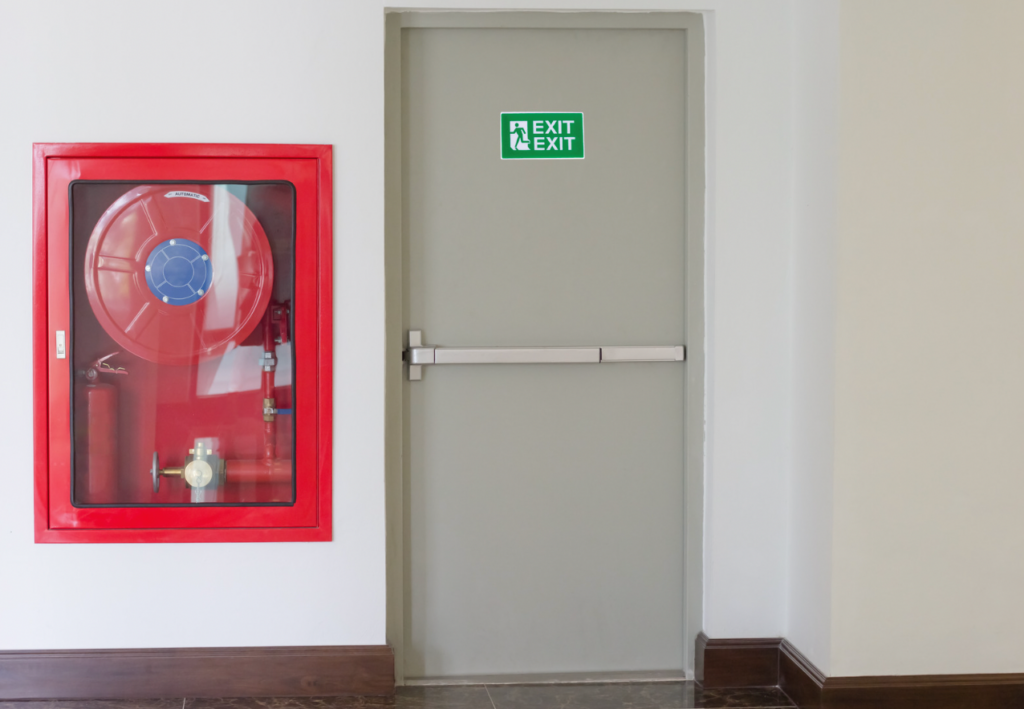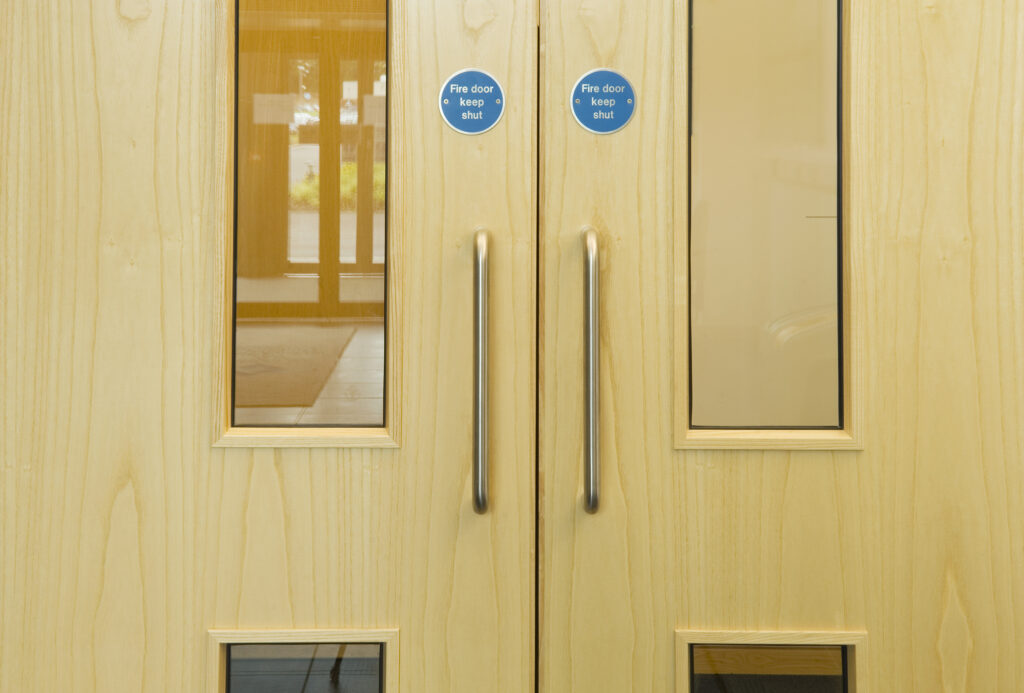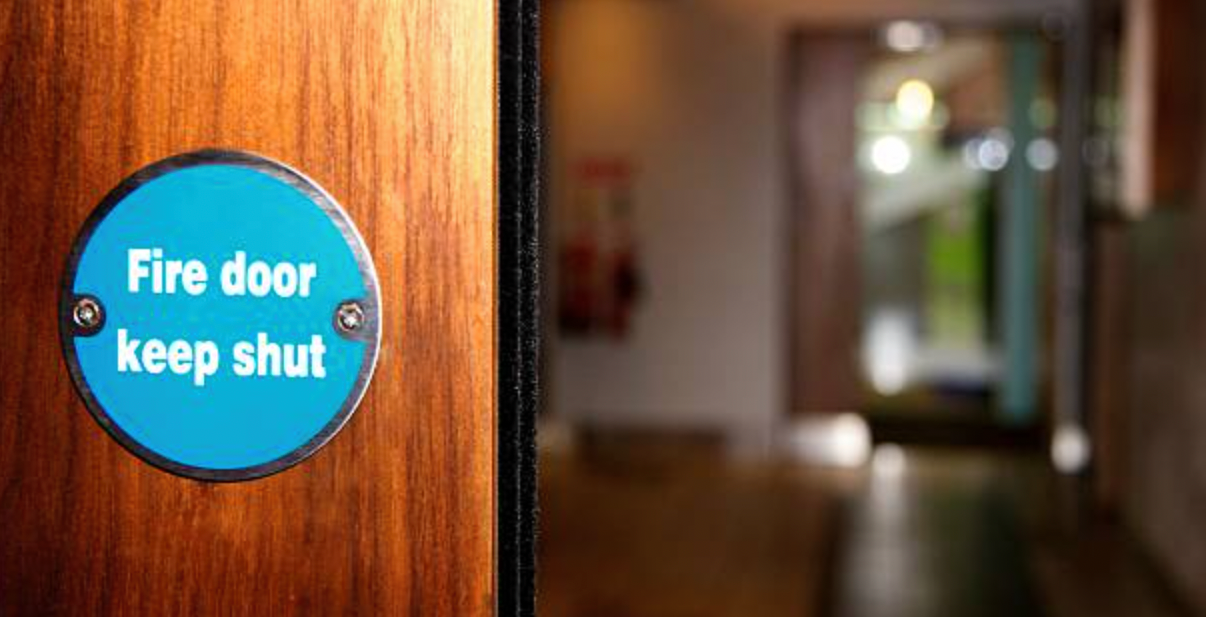Did you know there were 33,180 house fires in UK households last year? In an attempt to reduce this figure, the UK government have introduced new regulations that came into effect in 2023. In this blog, we’ll be taking a look at fire door regulations, as well as what they’re made from and why they’re required by law.
What Are Fire Doors?
Fire doors are an important part of any building’s fire safety system. They are designed to contain fires and limit the spread of smoke and toxic gases for as long as possible, providing a safe escape path for occupants. Fire doors consist of solid-core or hollow-core components tested and certified to meet specific fire safety ratings. Fire doors are typically made from metal alloys or wood but may also be constructed from a combination of materials such as fire-resistant glass and masonry.
In addition to their primary purpose of containing fires, fire doors can provide acoustic insulation, security benefits, and even aesthetic appeal to a building’s interior design. Depending on the type of opening, fire doors can be equipped with various features, such as automatic door closers and panic hardware, to ensure that they remain securely closed in the event of a fire. Fire doors are required in many commercial and public buildings, including hospitals, schools, universities, government buildings and industrial complexes.
How Do You Identify A Fire Door?
One of the easiest ways to identify a fire door is by checking the edge of the door by the hinge. Here you’ll likely find a metal identification tag that states the type of fire door, the fire rating and how long it will prevent fire and smoke from passing through into the rest of the building.
If the door has been checked as part of the fire door inspection scheme, the identification tag will be signed and dated to indicate an accredited fire door inspector has checked it. You may also find a sticker indicating the door conforms to British Standards 476: Part 22 or meets the EN 1634-1 standard for use in fire separations in buildings.
What Are The Different Types Of Fire Doors?
Fire doors come in different shapes and sizes. Let’s take a look at them:

Double Fire Doors
This type of fire door is typically installed in the corridors of large buildings, e.g. schools, hospitals and hotels. They’re also usually located by emergency exits and are a popular type of fire door.

Glass Fire Doors
Glass fire doors are composed of many layers of fire-resistant glass. Combined with intumescent seals, they’re a less popular alternative to traditional wood and steel doors.
Pre-Hung Fire Doors
Pre-hung fire doors are a complete unit delivered and ready to install. The installation process is very straightforward, meaning that they’re a great option if you’re looking to comply with building regulations.

Steel Fire Doors
These can be used in both commercial premises, as well as in residential buildings. Steel doors are extremely durable and reliable, making them an ideal choice for ensuring maximum safety in case of a fire.

Wooden Fire Doors
Wooden fire doors are a great option for those who want to add a touch of elegance and style to their home or business. They provide excellent protection against fire while still remaining aesthetically pleasing.
What Are Fire Door Regulations?
Fire door regulations are a set of rules that must be followed when installing, maintaining and using fire doors. In the UK, fire door regulations are established by The Regulatory Reform (Fire Safety) Order 2005. This order stipulates that commercial and public buildings must have a minimum of 30 minutes of integrity and insulation in any structural elements that directly separate two compartments or floors, as well as any external walls or other openings leading to an open area.
In 2023, this was updated to state that it will now be a legal requirement to have annual checks of flat entrance doors and quarterly checks of communal doors in multi-occupied residential buildings above 11 meters. The regulations also require responsible persons to provide their residents of all multi-occupancy residential buildings with information on the importance of fire doors to a residential building’s fire safety.
Why Are Fire Door Regulations Changing?
After the Grenfell tragedy in 2017, the government recognised that there were gaps in fire safety regulations. As a result, they are introducing new and updated regulations to ensure that existing buildings have reached the current fire safety standards and have the correct fire door assembly.
The new regulation seeks to address the issue of flat entrance doors, which can be easily bypassed or deactivated by residents and visitors alike due to a lack of awareness of their importance. The regulations are also being updated to reflect the installation of advanced fire safety systems such as automated closing devices, smoke seals and self-closing doors, which can provide additional protection from the spread of fire in multi-occupancy residential buildings.
What Are The Internal And External Fire Door Regulations?
Internal fire doors are meant to divide the building into separate compartments to stop fire spreading and smoke from travelling between rooms. However, external fire doors are not needed for fire protection. Instead, they are placed at the end of an escape route and don’t have to be kept close or have fire-resisting properties.

Facilities Management Companies
Hiring an excellent facilities management company can be beneficial in many ways if you’re an owner of a residential or commercial building. They will be able to ensure that the building complies with the fire door regulations and provide a range of other services such as general maintenance and health and safety checks. They can also advise you on maintaining fire doors, including fire door assemblies and checks. Here at Global Facilities, we have a highly experienced team of professionals that can ensure your building is compliant with fire door regulations. Contact us today to find out more.
Conclusion
Fire doors play a huge role in proactively preventing the spread of fire and smoke and providing a safe means of escape for occupants. It’s important to ensure that your fire doors are installed professionally and comply with the relevant regulations. By following these guidelines and finding a reliable facilities management company, you can ensure that your building is up to code and that everyone inside will be safe in the event of a fire.
We hope this guide has helped you learn more about fire door regulations and why staying compliant is important. Remember, a properly installed and maintained fire door is vital for the safety of your building and its occupants. For any questions or queries regarding fire door regulations, don’t hesitate to contact us here at Global Facilities today. We’d be happy to provide advice and assistance with any fire door-related needs you may have.
Fire Door Regulation FAQs:
We've done our best to try and answer the most frequently asked questions about fire door regulations below:
The Fire Safety Regulations 2022 has made it a legal requirement for multi-occupied residential buildings with storeys over 11 metres in height to carry out quarterly checks and annual checks of flat entrance doors.
An FD30 fire door is one that is 30 minutes fire and smoke resistant. It is currently a requirement that the front doors to flats are FD30.
You are not recommended to attempt to fit a fire door by yourself. They must be installed and checked by a fire safety professional to ensure they'll be effective in the event of a fire.
Yes, all fire doors are required to have three hinges which must be certified.
Fire doors should be checked regularly to ensure they are in good condition and damage-free. They must also be kept closed while not in use, and the seals around the door must remain intact.






